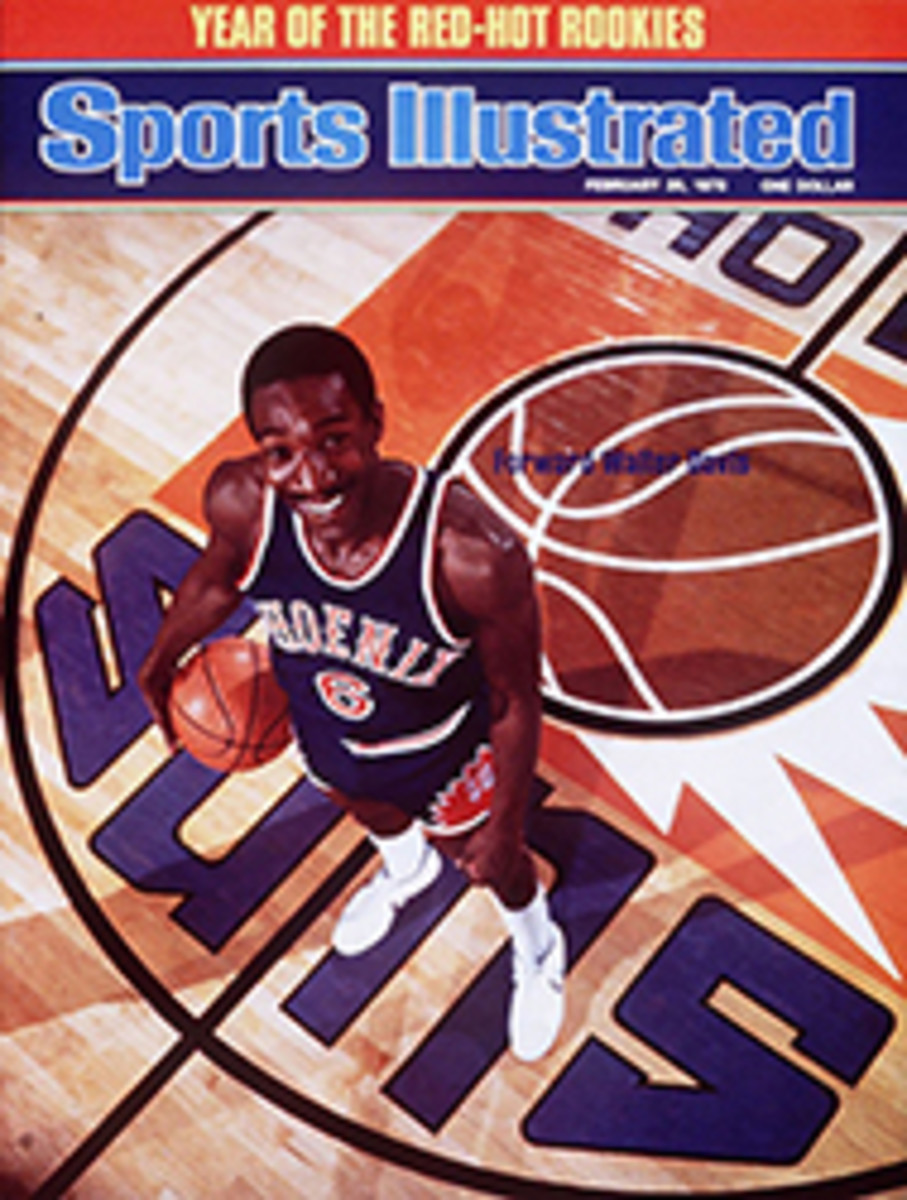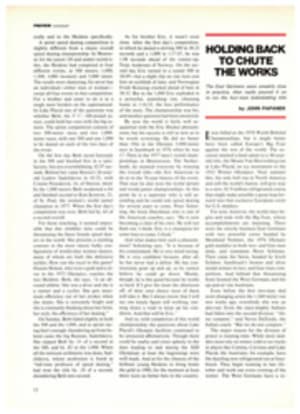
Williwaw is giving them the willies
Disturbed by a sagging entry list and rising costs, three years ago the management of the Southern Ocean Racing Conference attempted to attract sailors with old boats by dividing the annual competition into two sections: one for the expensive, new "grand prix" performers, and the other for hulls built before 1974. The idea, though sound, got nowhere. Three years ago the six SORC races drew 36 pre-1974 boats out of a fleet of 93. This year, in a comparable fleet, only 24 oldies showed up, and five of those elected to race in the new division.
Although cruising sailors often stay with their beloved boats until death does them part, racing skippers on the SORC use theirs like Kleenex. Out of the 93 hulls competing in the first three races of this year's series, only 27 are more than two years old. Forty of them are one-year-olds, making their debuts. Despite the efforts of management, the SORC remains a costly crapshoot where both seaworthiness and comfort are diminishing considerations. Cumulatively, the 40 new hulls cost about $5 million. For such fancy money, one should expect ships wellfound enough to make it over the 1,100-odd miles of the SORC, but last month before the first race—a 130-miler from St. Petersburg to Boca Grande, Fla. and back—was over, nine of the high-priced freaks had been crippled, six of them so badly it dashed their chances of winning any overall honors.
The winds in the Boca Grande race ranged from 20 to 30 knots, the seas were short and steep—tricky going, but nothing to tax the limits of intelligently used ocean craft. Regardless, five boats were dismasted, and the spar of another so warped she was forced to limp home. Four of the suffering craft were two-tonners built expressly for the Canada's Cup, a sort of desalinated America's Cup held every other year on the Great Lakes. If the fate of those four contenders in the SORC presages anything, and if Providence saves up a few summer squalls, this summer's Canada's Cup should be a gear-busting humdinger.
Mia VI, a prospective Canadian challenger for the cup, and Agape, a hopeful U.S. defender, were among those dismasted in the Boca race. Black Majic, another U.S. contender, struck something in the water. It was a glancing blow, a few feet forward of the shrouds, the impact barely jolting, the sound little more than a soft crunch; still, the five-ply laminated hull gave way as if it were made of case-hardened pecan shells. The hole was big enough to put an arm through. Warwick Tompkins, a crewman who sailed east to west around the Horn before half of the present SORC sailors were born, managed to tamp the hole using a vinyl garbage bag, towels, a blanket, a bunk top, boathook, coat rod, anchor and God knows what all. Summing up feelings that have been growing in him for some time, Tompkins said, "In the last six to eight years the boats have been getting steadily less wholesome and attractive to sail. They are more and more complicated, less and less safe. To my way of thinking, they are frightening."
They are also uncomfortable and un-livable. Because of her sparse interior, Williwaw, the two-tonner that won overall honors two years ago, was likened to an unrenovated Quonset hut. Because of her tubular internal skeleton, which affords rigidity while leaving her ends remarkably light, little Imp, last year's big winner, was called the "unbeatable boiler room." The belowdecks of this year's technological marvel, the Canadian two-tonner Evergreen, resembles the crawl space beneath a tract development house. Evergreen has no lavatory facility worth the name. Her sink is a plastic trash basket with no outlet; her stove consists of two gimbaled propane burners hung on either side of the so-called sink. Her secondary bulkheading, rather than transverse, is longitudinal and slants crazily, so that, on first going below, one gets the feeling he is in a fun house for midgets. The tiered bunks are between the canted bulkheads and the hull sides. The cushions of the lower, aftermost pair are 14 inches wide at the head, tapering to three inches at the foot. After a look at the crammed quarters, a rival crewman, Ron Love, declared, "I'd hate to be sleeping in the stern and have her start to sink fast. I wouldn't get in the damn berth without a fire ax."
Among the new boats this year, there are half a dozen ranging in price from 50 grand to half a million that in defiance of the hot-rod trend—and the winning percentage—are very well appointed below. At the bottom of the price range is a 40-footer called Decision, a Morgan-built custom boat designed for level-rated racing. In the middle of the range is Southern Star, a product of the Gulfstar company, skippered by her designers, the Lazzara brothers. Stepping from one of the little laminated one-tonners, which look like truncated ukuleles, into Southern Star is like going from a monocoque Indy car into a Mercury Monarch chauffeured by Catherine Deneuve. In addition to the usual amenities, such as enclosed lavatories and air conditioning, Southern Star has television and a Pong game for the amusement of the off watch.
The most that can be said for such sybaritic craft on the SORC is that they get an occasional taste of glory, and will probably get less in the final three races as the super machines put their acts together. In the second race of the series, mirabile dictu, Southern Star actually won the third-place silverware in Class A. After two races, Decision, the stocker skippered by Sailmaker Ted Hood, stood fifth in Class C, one place ahead of Evergreen, the seagoing crawl space skippered by Sailmaker Lowell North. Then in the third race. Evergreen took fourth, and Decision 15th.
The fates seemed to favor no special kind of boat, old or new, stripped out or well-appointed. After fetching some of the little and middle-sized new boats a wallop in the Boca race, the weather eased. In the 390-mile second race, from St. Petersburg around to Fort Lauderdale, the wind rarely exceeded 15 knots and all 75 starters finished. In unofficial fleet scoring after two races, three little Class D boats—Mr. Jumpa, Rogues Roost and Mercury—were first, second and third. Then for last week's third race, a 198-mile triangular run across the Gulf Stream to Great Isaac Light in the Bahamas and back, the scales shifted again, as if favoring boats not altogether new or too old.
The boat profiting most was Love Machine, a stretched-out two-tonner that placed fifth in her class and 11th overall last year. In part because six of her rivals were knocked out in the Boca race. Love Machine won Class C. After she took a third in the Lauderdale race, her co-skipper, Tom Whidden, had said, "We consider ourselves the Washington Redskins of the sailing game, old but ready. Love Machine is not the best or the fastest boat, but she is prepared. We sailed conservatively and kept our rigging from going over the side." Although most of her slicker rivals were back in action, Love Machine won again in the Ocean Triangle to hold her class lead and fourth in fleet scoring. Mr. Jumpa and Rogues Roost kept first and second in the fleet, but Mercury lost her third place to a brand-new Class B boat of secondhand design: Williwaw, the sixth so named and campaigned by Seymore Sinett. This Williwaw is skippered by Dennis Conner, the multifaceted sailor from San Diego.
Because in any race the weather may favor larger, faster boats over lesser rivals, or vice versa, three years ago the method of selecting an overall divisional winner was revised. Instead of ranking all boats from largest to smallest in order of their finishes in the six races, the prize now goes to the boat scoring best within its class. Conner had taken three consecutive firsts in his class, while the firsts in the other classes had been spread around, so at midpoint, in effect, he had the overall trophy halfway in his pocket. But Conner is never a man to win one way when it is possible to win two ways at once. After each race he assiduously figured out his score under the old system. Noting that, old style, he lagged 23.5 points behind Mr. Jumpa, he was undismayed, declaring, "I feel as fat and happy as a pig in heaven. We can get those points back in the Miami-Nassau race."
While Conner was oozing confidence, the world's most famous self-appointed underdog, Ted Turner, was hanging onto first place in Class A by his fingernails. By virtue of his successful America's Cup in secondhand Courageous and his Congressional Cup victory in Persephone. the very first Cal-40 built 15 years ago, he was voted U.S. yachtsman for 1977. (As one observer noted, "He's more than the yachtsman for 1977. He's the secondhand yachtsman of all time.") Because his secondhand ocean racer Tenacious is six years old, Turner could have had easy pickings in the old division, but he chose to mix it up with the hotshots. In the first race he took second to the 3-year-old Congere. In the next two he was second to a brand-new 51-footer, Acadia. But Acadia had carelessly busted three halyards in the Boca fiasco and finished well down, so despite her two firsts Turner still had a 1½-point lead. Turner thrives on squeakers, and in this one, as he customarily does, he rallied himself and his comrades with open disparagement. "We may not be the best yachtsmen in the world," he said, "but we used to be."
What the final three races will bring for the pacesetters and also-rans depends on the weather and the common sense of the men who are driving these complicated machines to the very edge. For certain, the challenge is already spoiled this year for half a dozen boats that exceeded the limit, forgetting the fundamental rule that before you can win, you have to finish.
PHOTO
Class C boats leave Miami and head for the Bahamas on the first leg of the Ocean Triangle Race.

